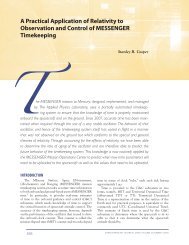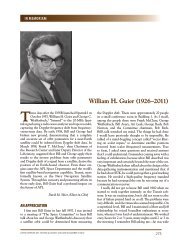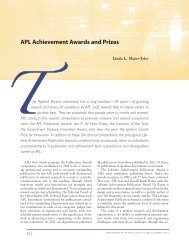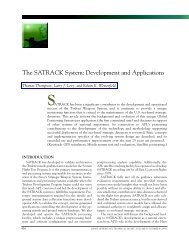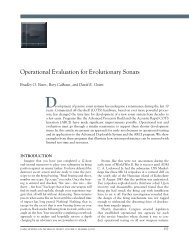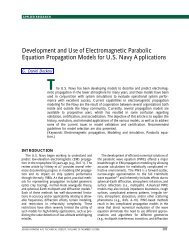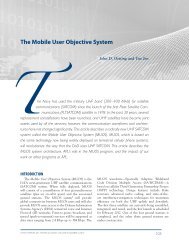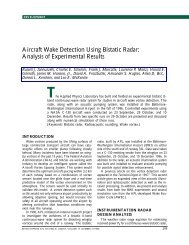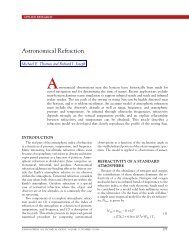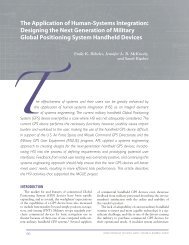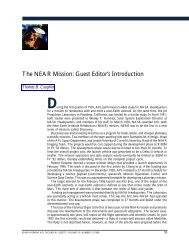An Overview of the JHU EPP Computer Science - Johns Hopkins ...
An Overview of the JHU EPP Computer Science - Johns Hopkins ...
An Overview of the JHU EPP Computer Science - Johns Hopkins ...
Create successful ePaper yourself
Turn your PDF publications into a flip-book with our unique Google optimized e-Paper software.
security was established in 2002. This area was coordinated<br />
with gerry masson, who at <strong>the</strong> time served<br />
as chair <strong>of</strong> homewood’s cs Department and now<br />
serves as Director <strong>of</strong> Jhu’s information security institute<br />
(Jhuisi). There are now nine courses <strong>of</strong>fered in<br />
information security, and Jhuisi students can take<br />
many <strong>of</strong> <strong>the</strong>m.<br />
EMERGENCE OF THE<br />
INFORMATION SYSTEMS<br />
AND TECHNOLOGY PROGRAM<br />
At <strong>the</strong> height <strong>of</strong> <strong>the</strong> dot-com boom in <strong>the</strong> latter part<br />
<strong>of</strong> <strong>the</strong> 1990s, <strong>the</strong> demand for iT courses <strong>of</strong> all types was<br />
high. students with diverse backgrounds were seeking<br />
to enter <strong>the</strong> iT field, even if <strong>the</strong>y did not have technical<br />
degrees. in response to <strong>the</strong> growing national demand for<br />
iT education, many universities established iT departments,<br />
and sometimes even schools. students flocked to<br />
<strong>the</strong>se programs, but many were seeking deeper technical<br />
insights and less emphasis on <strong>the</strong> business-oriented<br />
courses that were <strong>of</strong>ten core to those programs.<br />
While students from all technical disciplines have<br />
always been welcome to join <strong>the</strong> cs program, <strong>the</strong> prerequisites<br />
in math and cs can be daunting for those with<br />
degrees in disciplines such as education or business. epp<br />
recognized <strong>the</strong> need for a program that would be technically<br />
rich while appealing to a broader student body<br />
than that comprising cs. consequently, in 1997, epp<br />
established a new master’s Degree program in is&T.<br />
semmel and roger Westgate, who had been Associate<br />
Dean responsible for part-time engineering education<br />
and <strong>the</strong>n acting Dean <strong>of</strong> Jhu’s Whiting school <strong>of</strong><br />
engineering, gave a detailed description <strong>of</strong> <strong>the</strong> inception<br />
<strong>of</strong> <strong>the</strong> is&T program in an earlier Technical Digest<br />
article. 6 given <strong>the</strong> program’s initial leveraging <strong>of</strong> applied<br />
cs courses, semmel served as <strong>the</strong> first chair. he turned<br />
over chair responsibilities to bruce coury in 1998 but<br />
continued his association as cs coordinator for is&T.<br />
coury, at <strong>the</strong> time an ApL researcher and former pr<strong>of</strong>essor<br />
in industrial engineering, could serve as chair<br />
for only 1 year and transitioned leadership to Allan<br />
bjerkaas in 1999.<br />
upon being appointed Associate Dean for epp,<br />
bjerkaas asked semmel to again assume leadership <strong>of</strong> <strong>the</strong><br />
program in 2002. in his second tour as chair, semmel<br />
appointed John piorkowski as <strong>the</strong> is&T coordinator.<br />
in this role, piorkowski, an ApL staff member who<br />
had been teaching and advising in <strong>the</strong> is&T program,<br />
assumed responsibility for many <strong>of</strong> <strong>the</strong> is&T planning<br />
and operational activities.<br />
by design, is&T is <strong>the</strong> most eclectic degree program<br />
<strong>of</strong>fered in epp. students can take nonelective courses<br />
from is&T, cs, systems engineering, and Technical<br />
management as well as two elective courses from up to<br />
two additional epp programs. This eclectic orientation<br />
cs/is&T grADuATe progrAms<br />
has made is&T a natural focal point for collaborative<br />
efforts with o<strong>the</strong>r Jhu schools. For example, is&T has<br />
led an effort for epp in a joint initiative with <strong>the</strong> school<br />
<strong>of</strong> pr<strong>of</strong>essional studies in business and education to<br />
<strong>of</strong>fer <strong>the</strong> five-course graduate certificate in Technical<br />
innovation and new Ventures.<br />
PROGRAM HIGHLIGHTS OF THE<br />
PAST 10 YEARS<br />
Offerings and Requirements<br />
There are currently nine concentration areas in <strong>the</strong><br />
cs program, and more than 80 graduate courses and 5<br />
undergraduate prerequisite courses are <strong>of</strong>fered (see <strong>the</strong><br />
box, cs concentration Areas). students must take a set<br />
<strong>of</strong> three foundation courses in algorithm analysis, computer<br />
architecture, and s<strong>of</strong>tware engineering, and <strong>the</strong>n<br />
three courses in a concentration area <strong>of</strong> <strong>the</strong>ir choice.<br />
The remaining courses are electives, two <strong>of</strong> which may<br />
be taken from relevant programs outside cs. highly<br />
qualified students nearing completion <strong>of</strong> <strong>the</strong> degree<br />
may pursue independent study with cs faculty to add<br />
depth in a particular area or to pursue specific research<br />
interests.<br />
At <strong>the</strong> undergraduate level, students who are seeking<br />
a master’s degree in cs and who are entering from<br />
fields outside cs are expected to hold a technical degree<br />
and have taken courses in Java or c++, data structures,<br />
machine organization, and discrete ma<strong>the</strong>matics or o<strong>the</strong>r<br />
math courses beyond calculus ii. students who have not<br />
satisfied <strong>the</strong>se prerequisites may take <strong>the</strong> undergraduate<br />
courses <strong>of</strong>fered by Jhu. similarly, students entering bioinformatics<br />
but who do not have biology backgrounds<br />
must take undergraduate courses in biology and biochemistry.<br />
To facilitate <strong>the</strong> entrance <strong>of</strong> cs and o<strong>the</strong>r<br />
engineering students into <strong>the</strong> bioinformatics program,<br />
a special cs undergraduate course has been developed<br />
that covers <strong>the</strong> necessary molecular biology needed for<br />
graduate bioinformatics classes.<br />
The is&T curriculum is structured similarly to <strong>the</strong><br />
cs curriculum. students start with three required<br />
foundation courses in s<strong>of</strong>tware engineering, networking<br />
and telecommunications, and decision support<br />
systems. The course in s<strong>of</strong>tware engineering is <strong>the</strong><br />
same foundation course required <strong>of</strong> students pursuing a<br />
graduate degree in cs, while <strong>the</strong> o<strong>the</strong>r two are tailored<br />
for <strong>the</strong> is&T graduate degree and are not available to<br />
cs students. The remaining courses must include at<br />
least two advanced is&T courses. up to two electives<br />
outside is&T are permitted, with students typically<br />
choosing courses in cs, Technical management, and<br />
systems engineering.<br />
While is&T does not have concentration areas, <strong>the</strong><br />
<strong>of</strong>ferings are being evaluated to create areas that could<br />
serve as a basis for a depth requirement similar to that in<br />
cs. currently, 14 is&T-specific courses are <strong>of</strong>fered (see<br />
<strong>Johns</strong> hopkins ApL TechnicAL DigesT, VoLume 26, number 3 (2005) 231




